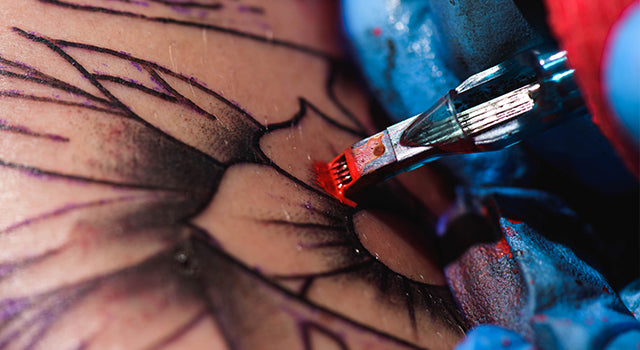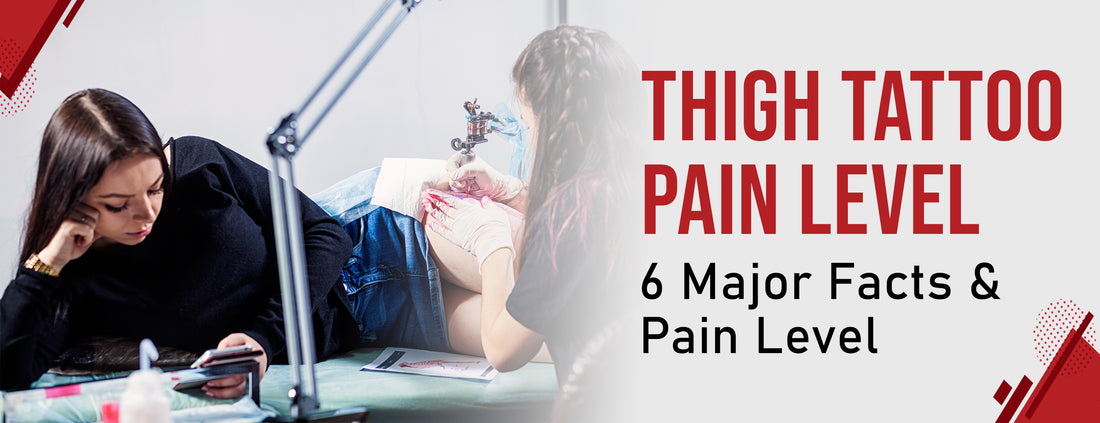Are you planning to get a tattoo on your thigh but concerned about the pain level? The pain scale for thigh tattoos ranges from 4-7 out of 10.
The pain experienced during a thigh tattoo is due to the high concentration of nerves, muscles, and tissues. The density of the skin makes needle penetration more challenging. The constant flexing and movement of the thigh add to the discomfort.
In this blog post, we will discuss the pain level on various parts of the thigh, the factors affecting the pain level, tips for managing the pain, and the aftercare for thigh tattoos. So, if you plan to get a thigh tattoo, keep reading to learn more about the pain level before you get inked.
Thigh Tattoo Pain: Factors that Affect

By understanding the different areas of the thigh and their level of sensitivity, you can make an informed decision about where to place your tattoo and prepare yourself for the experience. We will discuss the various factors that make the thigh a painful area for tattoos and the different locations on the thigh, and their pain levels.
Inner Thigh
The inner thigh has a high concentration of nerves and softer skin, making it one of the most sensitive and painful areas to get a tattoo. This area is also prone to rubbing and irritation, which can add to the discomfort. Preparing mentally and physically before getting a tattoo in this area is essential.

Back of the Thigh
The back of the thigh has tougher skin and denser muscle tissues than the inner thigh, making it less pain-sensitive. The sitting position required during the tattooing process may cause some strain on the leg muscles, adding to the discomfort.
Front of the Thigh
The front of the thigh is an ideal area for larger tattoos, but it can be challenging to sit still in a comfortable position due to the natural curvature of the leg. It's generally less sensitive to pain and discomfort compared to the inner thigh.
Outer Thigh
The outer thigh is the least sensitive area due to thicker skin and fewer nerve endings. It's easier to situate the leg comfortably while tattooing this area, but it may be vulnerable to rubbing and irritation.
Ranking of Pain Levels for Each Area with A Rating
Based on the above discussion, we have ranked the following areas according to their pain levels:
- Inner Thigh: High sensitivity (rating: 8/10).
- Front Of The Thigh: Medium sensitivity (rating: 6/10).
- Back Of The Thigh: Low sensitivity (rating: 4/10).
- Outer Thigh: Minimal sensitivity (rating: 2/10).
Managing Thigh Tattoo Pain: Tips and Techniques

By following these professional tips and techniques, you can manage thigh tattoo pain and enjoy a smooth and successful tattooing process that reflects your unique personality and style. Here are some professional tips and techniques to ease pain and reduce discomfort.
Finding a Professional
The first and most crucial step in managing thigh tattoo pain is to find a reputable and experienced tattoo artist. Your tattoo artist will help you choose the design and placement that suits your style and preferences and guide you through the tattooing process, ensuring safety, hygiene, and quality. When looking for a professional for your thigh tattoo, consider the following:
- Check the artist's portfolio and reviews to assess their skills and reputation.
- Visit the studio and inspect the equipment, hygiene, and ambiance.
- Ask about their experience with thigh tattoos and pain management techniques.
Getting Proper Sleep Before the Appointment
Getting enough sleep before your appointment can significantly reduce stress, anxiety, and pain sensitivity during tattooing. Lack of sleep can disrupt your immune system, weaken your pain threshold, and make you more prone to bleeding and infection. To ensure a good night's sleep:
- Avoid caffeine, nicotine, and alcohol before bedtime.
- Create a relaxing bedtime routine, such as taking a warm bath or reading a book.
- Set your sleeping environment to a comfortable temperature and low lighting.
Proper Eating and Hydration
Proper nutrition and hydration are essential for managing thigh tattoo pain and promoting healing. Eating a balanced diet rich in protein, vitamins, and antioxidants can strengthen your immune system, reduce inflammation, and speed up tissue regeneration. Drinking enough water and other fluids can keep you hydrated, prevent dehydration, and flush out toxins from your body. Here's what you should eat and drink before and after your thigh tattoo:
- Eat a healthy meal with lean protein, whole grains, leafy vegetables, and fruits to provide energy, increase blood flow, and lower inflammation.
- Avoid heavy, greasy, and spicy foods that cause indigestion, bloating, and nausea.
- Drink at least 8-10 glasses of water or other non-alcoholic fluids to prevent dehydration and moisturize your skin.

Taking Tylenol or Other Pain Medications
Pain medications such as Tylenol or ibuprofen can help reduce thigh tattoo pain and inflammation. You should consult with your physician or tattoo artist before taking any medication to ensure that it doesn't interfere with your health or the tattooing process.
Using Numbing Creams or Sprays
Numbing creams or sprays containing lidocaine or benzocaine can reduce thigh tattoo pain. These products block the nerve receptors that transmit pain signals to the brain, making tattooing less uncomfortable. You should only use numbing products approved by your physician or tattoo artist and follow their instructions on application and dosage.
Other Pain Relief Methods
Apart from the above techniques, there are several other pain relief methods you can try to ease thigh tattoo pain and discomfort:
- Distraction therapy: Listen to music, watch a movie, or converse with your tattoo artist to divert your attention from the pain.
- Deep breathing: Practice slow breathing to relax muscles, improve oxygen supply, and reduce pain perception.
- Topical cooling: Applying a cold compress or ice pack to the tattooed area can help numb the pain, decrease inflammation, and prevent bruising.
- Positioning: Lying down or sitting comfortably can ease the pressure on your thigh and reduce pain intensity.
How to Take Care of the Tattooed Area: 9 Tips

Proper aftercare is crucial when getting a thigh tattoo to ensure optimal healing results and prevent potential risks and complications. The following tips can help you take care of your tattooed area after getting inked:
Proper Cleaning and Moisturizing
- Keep the area clean: For the first few days after getting your thigh tattoo, it is essential to clean the room properly to prevent infection. You should gently wash the area with mild soap and water, and pat dry using a clean towel. Avoid using abrasive or scented products that can irritate the skin.
- Apply an ointment: After washing, applying a thin layer of cream designed explicitly for tattoo aftercare, such as A+D ointment, is recommended. These ointments can help moisturize the skin and prevent scabbing and itching.
- Avoid over-moisturizing: While keeping the tattooed area moisturized is crucial for preventing scabbing and dryness, it is also essential not to overdo it. Too much moisture can cause the tattoo ink to bleed out, leading to less sharp and vibrant tattoo lines and colors.
Avoiding Certain Activities
- Avoid swimming or soaking in water: For at least two weeks after getting your thigh tattoo, avoiding swimming, baths, or soaking in hot tubs is recommended. Exposure to water can increase the risk of infection and cause the tattoo to fade or blur.
- Steer clear of tight clothing: Wearing tight clothing such as skinny jeans or leggings can rub against your tattoo, which can irritate the skin and cause discomfort. Loose-fitting clothing is a better option as it allows air to circulate and promotes proper healing.
- Avoid sun exposure: Prolonged sun exposure will affect tattoo ink, fade and cause skin damage or sunburn. If you must be outside, ensure the tattooed area is covered with loose-fitting clothing or apply sunscreen with a high SPF.

Potential Risks and Complications
- Infection: One of the most significant risks associated with tattooing is the risk of disease. Signs of infection include redness, swelling, pus, and fever. If you suspect an infection, seek medical attention immediately.
- Allergic reactions: Some people may experience an allergic reaction to the tattoo ink, which can cause rashes, hives, or swelling. If you experience any unusual symptoms, contact your tattoo artist or a healthcare professional.
- Scarring: Improper aftercare can cause scarring or keloid formation. Following proper aftercare instructions is crucial to prevent this, and avoiding picking at scabs or touching the tattoo with dirty hands is crucial.
Conclusion
Getting a thigh tattoo can be an excellent choice for body art enthusiasts. Before you get a tattoo on your thighs, you should consider the potential pain level. The thigh area is known to be a sensitive spot, and the pain level can differ depending on the area of the thigh.
Tattoo size, design detail, skin sensitivity, and individual pain tolerance influence the pain level. To manage thigh tattoo pain, find a professional, get proper sleep, eat and drink correctly, take pain medication, use numbing creams, or use other methods.
Aftercare is equally crucial, so follow specific guidelines for proper cleaning and moisturizing and avoid certain activities that can damage your tattoo. With a meaningful and personal thigh tattoo in the right area and proper care, you can get a stunning piece of body art that will last a lifetime.










![Antibiotics and Tattoos: 3 Risks and 3 Effects [with 4 Precautions]](http://drnumb.com/cdn/shop/articles/Can_You_Get_Tattooed_On_Antibiotics__3_Risks_and_3_Effects_4_Precautions.jpg?v=1714128292)

